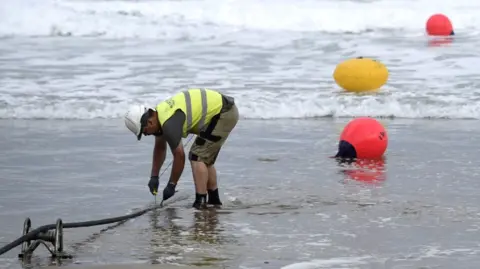The development of subsea fibre optic cables marked a crucial moment for global telecommunications, enabling rapid communication and data transfer across vast distances. In recent times, reports of damaged telecommunications cables, particularly in sensitive areas like the Baltic Sea, have prompted heightened security measures and innovative technology solutions aimed at monitoring and safeguarding these vital infrastructure components.
In a noteworthy advancement, AP Sensing, a technology firm based in Germany, has unveiled a system that allows subsea fibre optic cables to “listen for sabotage.” This monitoring system operates by detecting vibrations and disturbances in the cables caused by external elements, such as underwater drones or fishing vessels dragging anchors along the seabed. As the global reliance on fibre optic cables escalates, ensuring their security and continuity becomes increasingly critical, especially given the growing threats in geopolitical hotspots.
When a diver recently encountered a subsea fibre optic cable in the North Sea, the potential risks associated with such infrastructure became starkly apparent. This incident was part of a testing phase for AP Sensing’s monitoring system, which utilizes acoustic energy. As explained by Daniel Gerwig, the global sales manager at AP Sensing, when the diver gently touched the cable, it created disturbances detectable by the technology. This method of monitoring capitalizes on the principle that vibrations or disruptions in the fibre’s light signals can indicate external interference, thereby allowing for real-time surveillance of the cables.
The significance of protecting these cables is underscored by NATO’s recent initiative, “Baltic Sentry,” designed to patrol the Baltic Sea using aircraft, drones, and warships. This move is a direct response to the heightened vulnerability of these cables to sabotage and a recognition of their critical role in global communication. The European Union has similarly ramped up its protective measures, emphasizing the need for vigilant monitoring given the escalating incidents of cable damage.
However, challenges remain in ensuring comprehensive monitoring of subsea cables. The efficacy of the current monitoring methods is contingent upon the ability to strategically install signal listening devices, termed interrogators, along the cables at intervals of approximately 100 km (62 miles). While AP Sensing claims to detect disturbances from hundreds of meters away, the technology struggles to pick up signals over longer distances, making widespread coverage difficult.
Despite inherent vulnerabilities, advances in fibre optic sensing technology signify a positive trend in enhancing maritime security. Experts, including Paul Heiden from Optics11, suggest that deploying dedicated listening cables positioned away from critical assets could offer operators a broader awareness of maritime activities and potential threats. The feedback from these systems could be reconciled with satellite imagery and tracking systems for vessels, potentially allowing for proactive deterrence against sabotage.
Nonetheless, fibre optic cables, despite their protective measures, remain susceptible to damage. Incidents can occur even with double-armored cables when subjected to heavy impacts from vessels, particularly in high-risk areas. The ongoing maintenance and repair of these cables is essential, with over a hundred faults registered annually, showing a remarkable consistency in cable reliability, despite the ever-increasing number of installations.
In conclusion, while fibre optic cables have transformed the way we connect and communicate on a global scale, their protection presents an ongoing challenge. Technologies like those developed by AP Sensing represent a significant step forward in mitigating risks, enhancing monitoring capabilities, and ultimately safeguarding the critical infrastructure integral to the functioning of the modern digital world. The combination of advanced surveillance technology, military presence in vulnerable regions, and strategic cable management provides a multifaceted approach to securing our subsea communication networks.



